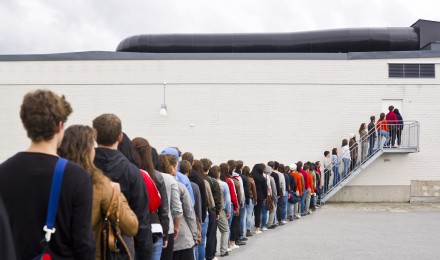The Labor Department initial claims measurement fell more than expected for the week ending February 23. Americans filed 22,000 fewer applications for benefits, dropping to 344,000 compared to 366,000 the prior week. This represents the lowest level for first-time claims since June 2008. Sequester—the massive round of spending cuts slated to take effect on Friday barring a last-minute reprieve—did not deter firms from maintaining current payrolls.
Bloomberg’s survey of 44 economists returned a median forecast of 360,000 claims. Compared to the same period in 2012, jobless claims have fallen 3%. The number of applications has ranged 330,000 to 375,000 over the last three months.
Four-week moving average
The four-week moving average of workers filing claims decreased to 355,000, a decrease of 6,750 from the revised 361,750 applications the week before. Economists, businesses, and investors pay closer attention to this indicator.
The 4-week moving average smoothes out volatility in the weekly employment data and eliminates the influence of unexpected events and weather.
Insured unemployment rate
The seasonally adjusted insured unemployment rate (IUR) decreased by to 2.4% a 0.1 percentage point decline from the previous week. The number fell by 91,000 people, from a prior week revised number of 3,165,000 to 3,074,000.
The insured unemployment rate refers to the number of unemployed people eligible to receive State unemployment benefits as a percentage of the numbers of the total number of individuals employed and also covered by unemployment insurance. The IUR does not include workers who have exhausted their unemployment benefits.
The 4-week moving average for this metric decreased by 35,000, falling from 3,190,500 the prior week to 3,155,000.
Employment remains stable
Despite a confluence of sequester concerns, rising prices at the pump, and bigger payroll taxes, the latest jobless claims data shows that consumer demand remains at a level that make companies comfortable enough to maintain their payrolls.
Nonetheless, economists and the Fed eagerly look forward to more job gains and robust economic growth after a lackluster quarter to end 2012. The U.S. economy expanded at an annual rate of 0.1 percent. The nation experienced its smallest trade deficit in nearly 36 months. This helped top balance the biggest drop in defense spending going back to the time of the Vietnam War.
Economist Kevin Cummins of UBS Securities LLC (Connecticut) anticipated an initial jobless claims number of 344,000, which is the lowest estimation among economists surveyed by Bloomberg. Cummins rates the economic recovery as “moderate when looking at growth.”
In addition, he believes the job market has “a little bit of momentum” and is “moving in the right direction.”
Unadjusted state data
For the week ending February, state programs reported an advance number of 307,589—a 43,208 decrease from the previous week. During the same period in 2012, workers filed 334,242 applications. With 152,148 fewer workers receiving unemployment benefits, the volume fell from the revised level of 3,668,711 to 3,516,563. At this point in 2012, 3,882,527 workers received unemployment benefits from state programs.
The total number of Americans claiming benefits in all program increased by 183,000 to 5,764,168 from the week before and 7,498,600 for the same week last year.
The Labor Department initial claims measurement fell more than expected for the week ending February 23. Americans filed 22,000 fewer applications for benefits, dropping to 344,000 compared to 366,000 the prior week. This represents the lowest level for first-time claims since June 2008. Sequester—the massive round of spending cuts slated to take effect on Friday barring a last-minute reprieve—did not deter firms from maintaining current payrolls.
Bloomberg’s survey of 44 economists returned a median forecast of 360,000 claims. Compared to the same period in 2012, jobless claims have fallen 3%. The number of applications has ranged 330,000 to 375,000 over the last three months.
Four-week moving average
The four-week moving average of workers filing claims decreased to 355,000, a decrease of 6,750 from the revised 361,750 applications the week before. Economists, businesses, and investors pay closer attention to this indicator.
The 4-week moving average smoothes out volatility in the weekly employment data and eliminates the influence of unexpected events and weather.
Insured unemployment rate
The seasonally adjusted insured unemployment rate (IUR) decreased by to 2.4% a 0.1 percentage point decline from the previous week. The number fell by 91,000 people, from a prior week revised number of 3,165,000 to 3,074,000.
The insured unemployment rate refers to the number of unemployed people eligible to receive State unemployment benefits as a percentage of the numbers of the total number of individuals employed and also covered by unemployment insurance. The IUR does not include workers who have exhausted their unemployment benefits.
The 4-week moving average for this metric decreased by 35,000, falling from 3,190,500 the prior week to 3,155,000.
Employment remains stable
Despite a confluence of sequester concerns, rising prices at the pump, and bigger payroll taxes, the latest jobless claims data shows that consumer demand remains at a level that make companies comfortable enough to maintain their payrolls.
Nonetheless, economists and the Fed eagerly look forward to more job gains and robust economic growth after a lackluster quarter to end 2012. The U.S. economy expanded at an annual rate of 0.1 percent. The nation experienced its smallest trade deficit in nearly 36 months. This helped top balance the biggest drop in defense spending going back to the time of the Vietnam War.
Economist Kevin Cummins of UBS Securities LLC (Connecticut) anticipated an initial jobless claims number of 344,000, which is the lowest estimation among economists surveyed by Bloomberg. Cummins rates the economic recovery as “moderate when looking at growth.”
In addition, he believes the job market has “a little bit of momentum” and is “moving in the right direction.”
Unadjusted state data
For the week ending February, state programs reported an advance number of 307,589—a 43,208 decrease from the previous week. During the same period in 2012, workers filed 334,242 applications. With 152,148 fewer workers receiving unemployment benefits, the volume fell from the revised level of 3,668,711 to 3,516,563. At this point in 2012, 3,882,527 workers received unemployment benefits from state programs.
The total number of Americans claiming benefits in all program increased by 183,000 to 5,764,168 from the week before and 7,498,600 for the same week last year.







